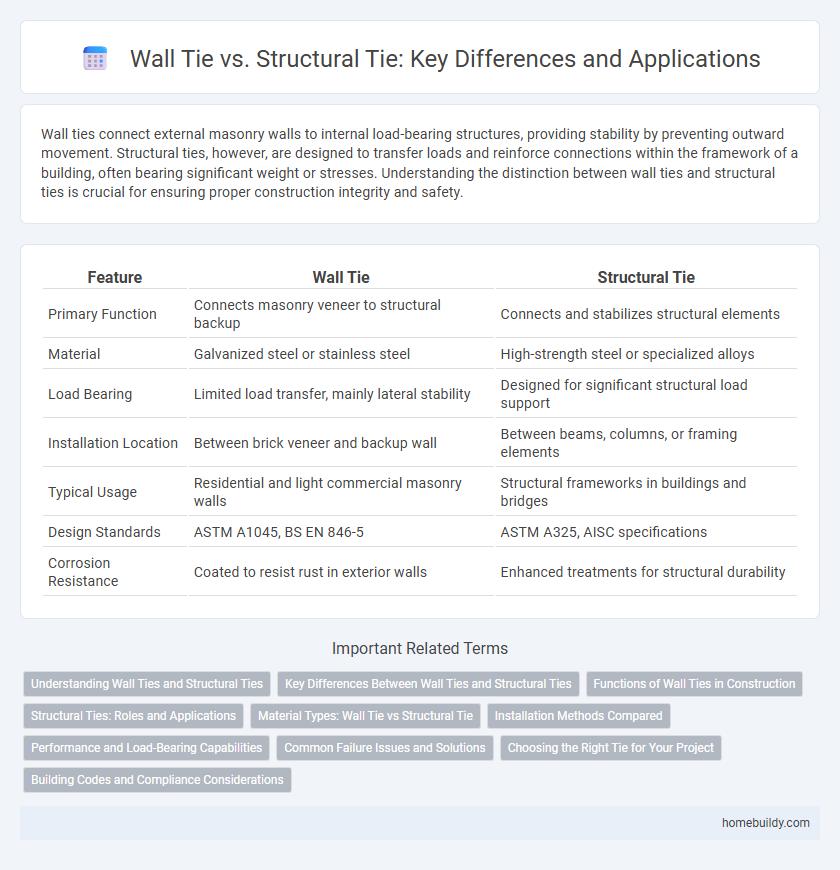Wall ties connect external masonry walls to internal load-bearing structures, providing stability by preventing outward movement. Structural ties, however, are designed to transfer loads and reinforce connections within the framework of a building, often bearing significant weight or stresses. Understanding the distinction between wall ties and structural ties is crucial for ensuring proper construction integrity and safety.
Table of Comparison
| Feature | Wall Tie | Structural Tie |
|---|---|---|
| Primary Function | Connects masonry veneer to structural backup | Connects and stabilizes structural elements |
| Material | Galvanized steel or stainless steel | High-strength steel or specialized alloys |
| Load Bearing | Limited load transfer, mainly lateral stability | Designed for significant structural load support |
| Installation Location | Between brick veneer and backup wall | Between beams, columns, or framing elements |
| Typical Usage | Residential and light commercial masonry walls | Structural frameworks in buildings and bridges |
| Design Standards | ASTM A1045, BS EN 846-5 | ASTM A325, AISC specifications |
| Corrosion Resistance | Coated to resist rust in exterior walls | Enhanced treatments for structural durability |
Understanding Wall Ties and Structural Ties
Wall ties are metal components embedded in masonry walls to connect the outer wall to the inner wall or structural frame, ensuring stability and load distribution. Structural ties differ as they are designed to transfer larger loads and provide critical support between structural elements, often used in frameworks and heavy construction. Understanding the distinct roles and load capacities of wall ties versus structural ties is essential for effective building integrity and safety.
Key Differences Between Wall Ties and Structural Ties
Wall ties primarily serve to connect and stabilize cavity walls by linking the outer and inner masonry wythes, preventing lateral movement. Structural ties, however, are designed to bear loads, transferring structural forces between different elements such as beams, columns, or walls, ensuring overall building integrity under stress. The key differences lie in their functions: wall ties focus on wall alignment and stability, while structural ties handle load distribution and structural support.
Functions of Wall Ties in Construction
Wall ties secure outer masonry walls to inner structural frameworks, enhancing overall stability and load distribution. They prevent lateral displacement caused by wind or seismic forces by transferring tension between wall layers. Effective wall ties also mitigate moisture penetration and thermal bridging, preserving building integrity and energy efficiency.
Structural Ties: Roles and Applications
Structural ties serve as crucial components in construction, enhancing the stability and strength of load-bearing walls by connecting various structural elements such as beams, columns, and floors. Unlike wall ties that primarily secure masonry veneers to backing walls, structural ties distribute stress and resist lateral forces, thereby preventing structural failure under dynamic loads. Their applications extend to bridges, high-rise buildings, and seismic-resistant structures where maintaining the integrity of the framework against shifting or settling is essential.
Material Types: Wall Tie vs Structural Tie
Wall ties are typically made from stainless steel, galvanized steel, or wire mesh, chosen for their corrosion resistance and durability in masonry construction. Structural ties, in contrast, often use high-strength steel alloys or carbon fiber composites to provide enhanced load-bearing capacity and tensile strength in structural applications. The material selection directly influences the tie's performance, with wall ties prioritizing durability and structural ties emphasizing strength and stability in load transfer.
Installation Methods Compared
Wall ties are typically installed by embedding them into the mortar joints of masonry walls to connect the outer and inner wythes, ensuring stability and load distribution. Structural ties, however, often require mechanical fastening methods such as bolting or welding to connect different structural components like steel beams and concrete elements. The installation of wall ties is generally simpler and integrated into the masonry process, whereas structural ties demand precise alignment and specialized tools for secure attachment.
Performance and Load-Bearing Capabilities
Wall ties primarily serve to connect non-load-bearing masonry veneers to the structural backing, ensuring stability without bearing significant loads. Structural ties are designed to transmit both lateral and vertical loads, providing essential load-bearing support within building frameworks. Performance-wise, structural ties exhibit higher mechanical strength and durability, crucial for maintaining building integrity under stress conditions.
Common Failure Issues and Solutions
Wall ties commonly fail due to corrosion, leading to reduced load transfer between masonry and supporting structures, while structural ties often experience stress-induced fractures compromising overall stability. Solutions include using stainless steel or galvanized materials to prevent rust and installing regular inspection programs to detect early signs of deterioration. Reinforcement with epoxy-coated ties and proper drainage systems enhances durability, minimizing failure risks in both wall ties and structural ties.
Choosing the Right Tie for Your Project
Wall ties and structural ties serve distinct purposes in construction, with wall ties primarily providing lateral stability between masonry wythes and structural ties offering load-bearing support in framing systems. Selecting the right tie depends on factors such as wall type, load requirements, and environmental conditions; wall ties are ideal for cavity wall reinforcement, while structural ties are essential for transferring loads in complex assemblies. Understanding material compatibility, corrosion resistance, and anchoring methods ensures optimal performance and durability for the chosen tie system.
Building Codes and Compliance Considerations
Wall ties and structural ties serve distinct roles in construction, with wall ties primarily used to connect masonry facing to backup walls, while structural ties provide load-bearing support within the building framework. Building codes mandate specific material strength, spacing, and corrosion resistance requirements for both types to ensure safety and durability. Compliance considerations include adherence to standards such as ASTM and local building codes, which govern installation methods and performance testing to prevent structural failures and maintain building integrity.
Wall tie vs Structural tie Infographic

 homebuildy.com
homebuildy.com